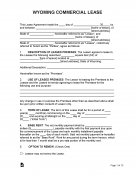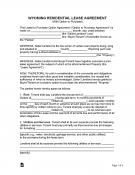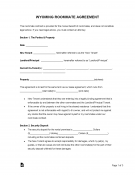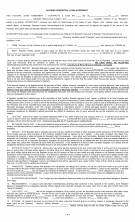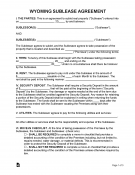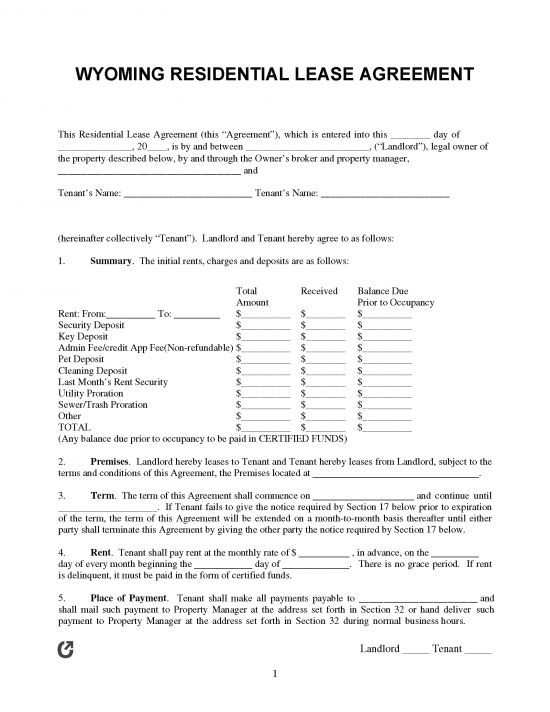Wyoming lease agreements are contracts that govern a tenant’s lease of a landlord’s property. The agreements are written and must be signed by both parties. Typical terms include the amount of rent, which party is responsible for which utilities, and other items that will be more specific to the property, such as whether pets are permitted. Both the landlord and the tenant should keep a copy of the lease agreement.
Contents
By Type (6)
- Commercial Lease Agreement
- Month-to-Month Lease Agreement
- Rent-to-Own Lease Agreement
- Roommate Lease Agreement
- Standard Lease Agreement
- Sublease Agreement
Download: Adobe PDF, MS Word, Rich Text Format
Download: Adobe PDF, MS Word, Rich Text Format
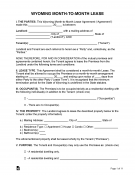 Month-to-Month Lease Agreement
Month-to-Month Lease Agreement
Download: Adobe PDF, MS Word, Rich Text Format
Download: Adobe PDF, MS Word, Rich Text Format
Download: Adobe PDF, MS Word, Rich Text Format
Download: Adobe PDF, MS Word, Rich Text Format
Landlord-Tenant Laws
Statutes – Title 1, Chapter 21, Article 12 (Residential Rental Property)
Required Disclosures (2)
Lead-Based Paint Disclosure – Under federal law, in leases of properties with dwelling units built before 1978, landlords must disclose the risks of lead-based paints.
Non-refundable Fees – Lease agreements must include whether any of the fees tenants are obligated to pay are nonrefundable, and if so which ones. (§ 1-21-1207)
Security Deposit Laws
Maximum Amount ($)
There is no maximum security deposit amount.
Returning to Tenant
Landlords must return security deposits to tenants within thirty (30) days of the termination of a lease agreement, or within fifteen (15) days of receiving a tenant’s new address, whichever is later. Landlords may retain a portion of the security deposit to account for owed rent, settle unpaid utility bills that the lease agreement made the tenant’s responsibility, clean the unit or repair damages beyond normal wear-and-tear, or remedying other violations of the lease agreement.
If the landlord chooses to retain a portion of the deposit, the landlord must also provide a written itemization explaining and documenting all deductions, along with any remaining funds. (If the landlord encounters damage to the unit, he or she shall have an extra thirty (30) days to return the deposit remainder and itemization.) It is the tenant’s responsibility to provide the landlord with a new address within thirty (30) days of the termination of the lease. (§ 1-21-1208)
When is Rent Due? (grace period)
Lease agreements may set the rent due date on any day the parties agree to, and there is no grace period.
Eviction Notice (non-payment)
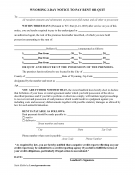 3-Day Notice to Pay or Quit – When a tenant does not pay rent on the date it is due, the landlord has the right to provide the tenant with this notice stating that, if the tenant does not pay all rent owed within three (3) days of the date the notice was delivered, then the landlord may terminate the lease and begin eviction proceedings. (§ 1-21-1003)
3-Day Notice to Pay or Quit – When a tenant does not pay rent on the date it is due, the landlord has the right to provide the tenant with this notice stating that, if the tenant does not pay all rent owed within three (3) days of the date the notice was delivered, then the landlord may terminate the lease and begin eviction proceedings. (§ 1-21-1003)
Download: Adobe PDF
Maximum Fees ($)
Late Rent Penalties
There is no stated maximum to what a landlord may charge as a late, nor guidance about when one may be charged. To assure that the fee is enforceable, best practice is to state the fee in the lease agreement, and for the fee to be reasonable.
NSF Checks
Landlords and other private parties who receive a “bad check,” including one that bounces, may seek full payment along with an NSF check fee of $30 by issuing a written demand for payment within thirty (30) days of receiving the bad check. (§ 1-1-115)
Tenant’s Unclaimed Property
If a landlord, after taking possession of a property following the end of a lease, encounters a past tenant’s personal property, the landlord may dispose of all non-valuable property.
For valuable personal property, the landlord should remove and store the property, and provide the tenant with written notice including a description of the property and a statement that the property may be destroyed after seven (7) days if the tenant fails to contact the landlord. (The landlord does not have a duty of care toward the tenant’s personal property while it is in storage.)
If the tenant does not respond within seven (7) days of providing the notice, the landlord may dispose of the property as he or she sees fit. (The notice requirement may be fulfilled by mailing it, delivering it personally, or through publishing an ad in a newspaper published in, or circulating widely within, the county where the property lies.) If the tenant responds and declares an intent to reclaim the property, the landlord must hold the property for an additional seven (7) days.
If the tenant subsequently arrives and claims the property, the landlord may seek reimbursement from the tenant for the cost of storing the property. If the tenant does not claim it within this time period, the landlord may dispose of the property as he or she sees fit. (§ 1-21-1210)
